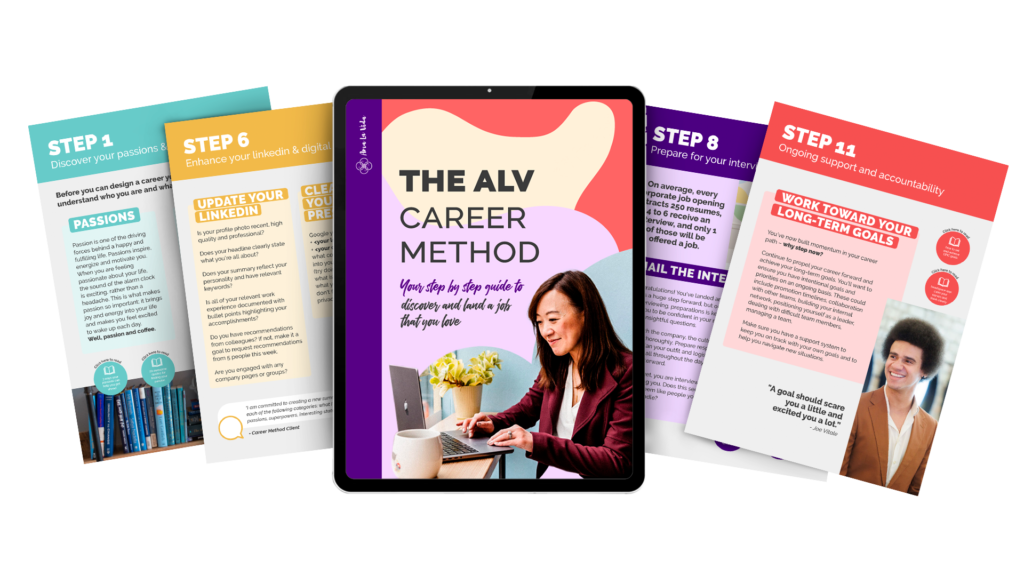Career Plans, Career Paths, Career Goals, and Why You Need Them All

In today’s dynamic and ever-evolving job market, the traditional notion of meticulously planning every step of your career journey and executing it flawlessly is becoming increasingly unrealistic. Instead, a more flexible and adaptive approach is necessary. This article explores the essential elements of career strategy—career goals, career paths, and career plans—and how to strategically navigate them to achieve career success.
Creating a Career Strategy: Taking Ownership of Your Career
Taking ownership of your career and consciously designing your life starts with creating a comprehensive strategy. This strategy comprises three key components: career goals, career paths, and career plans. Understanding and effectively leveraging these components will help you navigate the complexities of your professional development journey.
What is the Difference Between Career Goals, Career Paths, and Career Plans?
To build a successful career strategy, it’s important to understand the distinctions and interconnections between career goals, career paths, and career plans. Each plays a crucial role in your professional journey but serves different purposes.

Career Goal: Imagine Your Future
A career goal is about describing the strategic playing field for your desired career and the role you want to play within it.
It answers the fundamental question: What do you want to do?
Naming your goal involves identifying the industry or domain you wish to work in and the specific position or function you aim to achieve. Your career goal sets the direction and provides a clear target for your efforts.
Here are a few examples of career goals to get you started:
- Software Developer: If you love coding, gaming, and living in the Pacific Northwest, your career goal might be to secure a position working with a design team at a software games company in Seattle.
- Human Resources at a financial firm: If you like helping organizations get the best out of their workforce in high-pressure environments by working closely with people, and you enjoy the vibrancy of metropolitan life, your career goal might be to lead the HR department of a mid-sized financial company in a big city.
- Social Worker for at-risk youth: If you like working with young people who are trying to figure out how to get on the right track, and you love the idea of contributing to the well-being of your hometown, your career goal might be to work in a local community organization or government agency that focuses on supporting at-risk youth.
Take some time to reflect on your desired career future and clarify what you want.

Career Path Definition
A career path is about developing a sequence of career actions that you believe will get you from where you are to where you want to be in your professional life—your goal.
Your career path acknowledges that there can be multiple ways to reach your long-term goals and involves mapping out possible routes to achieve them. A career path provides a framework for your professional journey.
Here are some examples of career paths based on the goals we’re exploring:
- Software Developer: To become a software developer, your career path might include obtaining a degree in computer science, completing internships, gaining experience through entry-level positions, and continuously improving your coding skills.
- Human Resources at a financial firm: To become an HR director in the financial sector, your career path might include obtaining a degree in human resources or business administration, gaining experience through HR roles, obtaining HR certifications, and moving up to HR management positions.
- Social Worker for at-risk youth: To become a social worker working with at-risk youth, your career path might include obtaining a degree in social work, completing internships or volunteer work with at-risk youth, gaining on-the-job experience through entry-level social work positions, and obtaining necessary licenses and certifications.

Career Plan Definition
A career plan is about how you are going to move to the next step, and subsequent steps, of the path. It involves making strategic choices in your professional development about how to get from where you are to where you want to be.
This part is about taking your long-term career goals and translating them into short-term goals. Making your career plan includes selecting which path to follow out of the potential options and detailing the specific actions you will take to progress.
Your career plan outlines the tactical steps needed to achieve your career path and, ultimately, your career goal.
Here are what career plans might look like for each of our scenarios:
- Software Developer: Your career plan might involve applying for internships at tech companies, enrolling in relevant online courses, networking with professionals in the field, and preparing for technical interviews to secure your first job as a software developer.
- HR Manager at a financial firm: Your career plan might involve gaining hands-on experience in various HR roles, obtaining HR certifications like SHRM-CP or PHR, networking within the financial sector, and applying for HR management positions to build up to the role of HR director.
- Social Worker for at-risk youth: Your career plan might involve completing internships with organizations that work with at-risk youth, obtaining relevant certifications, attending workshops and conferences on social work, networking with professionals in the field, and applying for social worker positions focused on youth services.
The Importance of Ongoing Research and Adaptability
When you create a goal and a path, it’s based on what you know today. However, the information you have could be outdated, incomplete, or inaccurate. This is why your plan has to include ongoing research and adaptation.
Making the most of resources like working with a career coach, conducting online research, and talking to people who work in the career fields that interest you are crucial steps.
Conducting Ongoing Research
- Work with a Career Coach: A career coach can provide personalized guidance and insights based on their expertise and experience, and can help you think about how you can develop and carry out your plan. Learn more about working with a career coach right here.
- Online Research: Use online platforms, forums, and resources to stay updated on industry trends, required skills, potential employers, and job opportunities.
- Networking: Talk to other professionals who are already working in your desired field. Attend industry events, join professional organizations, and seek informational interviews to gain first-hand knowledge.

Your career goal will have helped you create a path and a plan. The plan should help you refine your path, and it might lead to changing your goal if you find out that what you are aiming for isn’t what you thought it was. Stay open minded – maybe your dream career is something you’ve never heard of before!
Strategy: The Foundation of Adaptable Planning
What we’re talking about here ultimately is having a career strategy. Strategy is a framework for guiding your efforts to create outcomes in an uncertain and ever-changing world. It’s about making informed choices, exploring different career paths, and being adaptable.
Developing your career strategy involves several key components, such as setting long-term career goals, identifying clear career objectives, and progressively taking on more responsibility.
By focusing on these elements, you can navigate your career with intention and flexibility.

Picking a Career Playing Field: Determine the Industry or Domain You Want to Explore
Choosing a career field means identifying the broad area or industry where you want to build your career. This decision lays the groundwork for all your subsequent career advancement choices and actions.
Here are some steps you can use to get a better idea of which career path is right for you:
- Research Industries: Look into various industries to understand their dynamics, advancement opportunities, and the types of roles they offer. Explore sectors that align with your interests and values.
- Assess Personal Interests: Reflect on what excites you and what you’re passionate about. Aligning your career with your interests can lead to greater job satisfaction and motivation.
- Evaluate Market Demand: Consider the demand for professionals in your chosen field. Industries with higher demand may offer more opportunities and better job security.
- Consider Long-Term Trends: Think about the future outlook of the industry. Are there emerging trends or technologies that could impact its growth? Position yourself in a field with promising prospects.
Identifying Key Beliefs: Understand What You Believe About Success in That Field, Which Shapes Your Career Goals
Identifying your key beliefs about success in your chosen field helps shape your career goals and sets the direction for your professional journey. This involves:
- Defining Success: Clearly articulate what success looks like to you. Is it climbing the career ladder and achieving a certain job title, having a significant impact, earning a specific income, making a positive impact, or attaining work-life balance?
- Learning from Others: Study the careers of successful individuals in your field. What paths did they take? What skills and attributes contributed to their success?
- Reflecting on Values: Ensure that your career goals align with your personal values and principles. This alignment will help you stay motivated and fulfilled.
- Setting Realistic Expectations: Understand the challenges and requirements of your chosen field. Set achievable goals that push you forward while being realistic about the effort needed.
Considering Choices: Make Strategic Decisions on How to Start and Progress in Your Career Path
Once you’ve identified your career goals and the field you want to explore, it’s time to make strategic decisions about how to start and progress on your career path today. This involves:
- Education and Training: Determine the qualifications and skills required for your desired roles. This might involve pursuing degrees, certifications, or specialized training programs to enhance your personal brand.
- Gaining Experience: Look for opportunities to gain relevant experience. This could include internships, entry-level positions, volunteer work, or freelance projects.
- Building a Network: Establish connections with professionals in your field. Attend networking events, join professional organizations, and seek mentorship to gain insights and opportunities, thereby strengthening your professional network.
- Skill Development: Continuously improve your skill set. Identify the key competencies needed for success in your field and actively work on developing new skills through courses, workshops, and self-study.
Searching for the Next Step: Develop a Plan for Continuously Searching for and Identifying the Next Steps in Your Career Journey
A successful career strategy involves continuously searching for and identifying the next steps in your professional and personal development journey. This process requires an adaptable mindset and a commitment to ongoing learning and growth:
- Regular Self-Assessment: Periodically evaluate your progress and reassess your goals. Are you moving in the right direction? Are there new opportunities or challenges to consider?
- Seeking Feedback: Solicit feedback from mentors, peers, and supervisors. Use their insights to refine your strategy and improve your performance.
- Staying Informed: Keep up with industry news, trends and developments. This knowledge will help you identify emerging opportunities and stay relevant in your field.
- Being Open to Change: Be willing to pivot or adjust your plans as needed. The career landscape is constantly evolving, and flexibility is crucial to navigating it successfully. Seek opportunities for growth and development to stay ahead in your career journey.
Conclusion
Whether you’re looking to change careers, get a new job, or work toward a pay raise or leadership position, having these tools available can help with your goal-setting process and project management of your career.

It’s important to remember that the key to a successful career is not just in meticulous planning, but doing enough thinking about your goals and path in order to create a plan—and then taking action!
The point of creating the plan is to get you out there so you can gain experience and learn what you need to learn to update your thinking. It’s a flexible and adaptive process.
While career goals, career paths, and career plans together provide structure and direction, they should be viewed as dynamic tools that evolve with your experiences and learning.
By embracing a strategy of continuous research and adaptability, you can navigate the ever-changing career landscape effectively and find fulfilling opportunities.
We don’t mean to make light of this process. Working with a career coach is a great place to start if you’re feeling at all overwhelmed. Book a free call today to learn more about our process and see if coaching is right for you.
Additional Resources








